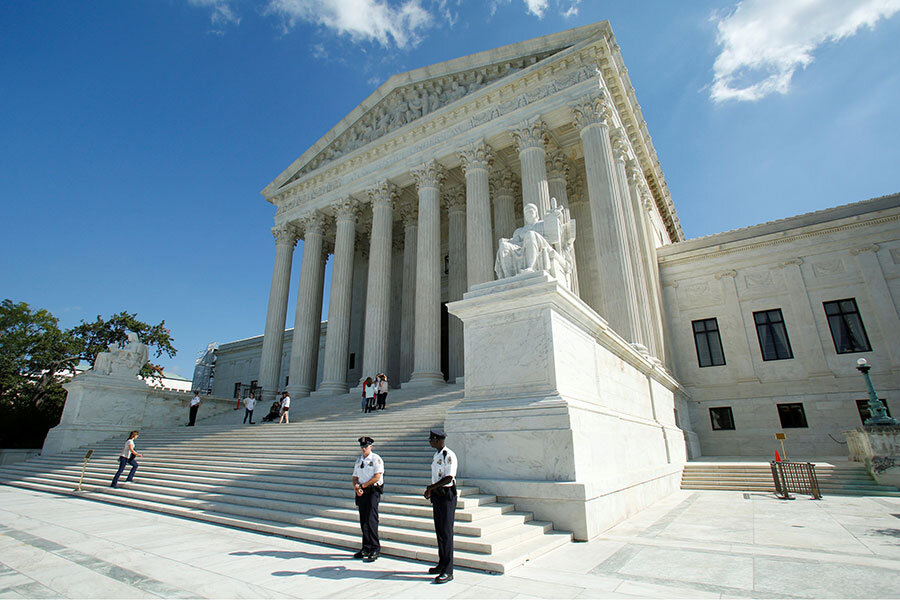With racism case, Supreme Court wades into death penalty debate
Loading...
| Washington
The United States Supreme Court, missing a justice and shrouded in political uncertainty, on Wednesday will wade into a fraught area of law at the intersection of two dynamic public issues: the death penalty and racial bias in the criminal justice system.
The case concerns a convicted murderer in Texas. In 1997 Duane Buck was sentenced to death after an expert defense witness said he was more likely to commit a violent crime again because he was black. By allowing that testimony, Mr. Buck’s lawyers gave him constitutionally ineffective legal advocacy that “powerfully undermines confidence in Mr. Buck’s sentence of death,” his current lawyers contend.
The case isn’t likely to have a seismic impact on capital punishment in America, experts say, partly because the racism was so blatant. But it raises stark questions about whether the court’s efforts to reform the death penalty 40 years ago have been fully realized.
It comes as public support for capital punishment hits 40-year lows amid growing concern about racial bias in the larger criminal justice system. In that way, the case could represent a chance for the justices to ask hard questions of the criminal justice system as a whole.
“One of the things that Buck represents is that despite multiple efforts to do so, the issue of race and race discrimination in capital sentencing … is just as prevalent today as it was in 1976 when the court put the modern death penalty into effect,” says John Blume, director of the Cornell Death Penalty Project at Cornell Law School in Ithaca, N.Y.
That 1976 decision, Gregg v. Georgia, rolled back a four-year, Supreme Court-imposed moratorium on the death penalty. It approved certain new requirements to states’ death-penalty statutes, including separating the trial and sentencing phases and requiring an automatic appeal.
The goal was to ensure that the death penalty was not “so wantonly and so freakishly imposed,” as Justice Potter Stewart put it in the ruling establishing the moratorium four years earlier.
America's shifting perspective
What has changed since then is “an awareness in our country that has never existed before about the very real impact of racial bias in the criminal justice system,” says Sara Totonchi, executive director of the Southern Center for Human Rights. “While race was certainly an issue 40 years ago, it was nowhere near as nuanced or as illuminated as what we have today.”
This debate over race in the justice system has shifted perceptibly in recent years. The get-tough-on-crime era of the 1980s and ’90s has been increasingly seen as having a devastating and disproportionate effect on the black community, with nonviolent criminals locked away for years. Moreover, the exonerations of dozens of death-row inmates have raised doubts about the integrity of the death-penalty process.
Add the recent botched executions, and some see the country and the court reconsidering the death penalty. Indeed, at 42 percent, public opposition to the death penalty has risen to its highest level since 1972, according to a href="http://www.pewresearch.org/fact-tank/2016/09/29/support-for-death-penalty-lowest-in-more-than-four-decades/?utm_source=AdaptiveMailer&utm_medium=email&utm_campaign=16-09-29%20Death%20Penalty%20FT%20post&org=982&lvl=100&ite=357&lea=54227&ctr=0&par=1&trk" data-mce-href="http://www.pewresearch.org/fact-tank/2016/09/29/support-for-death-penalty-lowest-in-more-than-four-decades/?utm_source=AdaptiveMailer&utm_medium=email&utm_campaign=16-09-29%20Death%20Penalty%20FT%20post&org=982&lvl=100&ite=357&lea=54227&ctr=0&par=1&trk">the Pew Research Center.
The Buck case plays on these concerns. Deciding against Buck, his lawyers say, “creates both a profound risk of injustice to Mr. Buck – who faces execution pursuant to a death sentence marred by racial bias – and a profound risk of harm to society’s confidence in the integrity of the criminal justice system.”
Texas counters that the expert’s testimony did not decisively influence the jury’s sentencing decision, and so his lawyers were not constitutionally ineffective.
Dramatic and decisive
While court watchers are typically loath to predict how the court could decide, most experts believe that the lack of a ninth justice has created a unique dynamic. The justices want to avoid ambiguous tie votes and so are only selecting cases they believe they can rule on decisively.
Separately, the court has also recently tended to select dramatic outlier cases involving the death penalty and racial discrimination.
Last term, the court ruled 7 to 1 that prosecutors in Georgia violated the constitution in striking every black prospective juror in a capital case, with Chief Justice John Roberts writing in the opinion that striking the prospective black jurors was “motivated in substantial part by discriminatory intent.” Also last term, the court ruled on unusual elements of the death-penalty systems in Florida and Alabama, finding Florida’s unconstitutional and ordering an Alabama appeals court to reconsider the constitutionality of its system. (The state supreme court ruled last week that the system is constitutional.)
“I think there’s been a disenchantment among [some] justices … about [the death penalty’s] efficacy as either a deterrent or as a fair retributive measure,” says John Boger, a professor at the University of North Carolina School of Law. “So the court has started again to take individual cases and reverse [lower court decisions] where it sees real improprieties.”
In other words, the court has been “more comfortable in reversing things in capital cases where they don’t feel that [the decision will affect] 50 other cases,” he adds. “If what you have is an outlier case in which some terrible thing has happened, they can stand for the principle without feeling that there are going to be a lot of other cases like this.”
Buck appears to be one of those cases, but amid broader national tensions on race and the criminal justice system, it comes at a “critical time,” Ms. Totonchi says.
“Buck is idiosyncratic in some respects” compared to other capital cases, Professor Blume adds. But the case is “an example, a rather dramatic example, but an example of the fact that the death penalty in the United States, as currently administered, is riddled with racism.”








